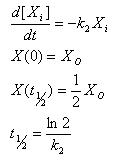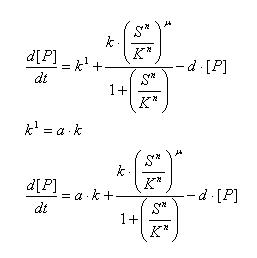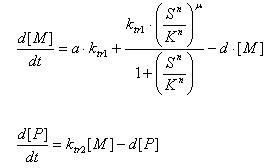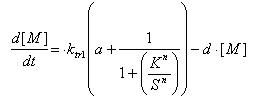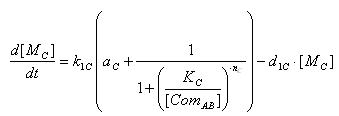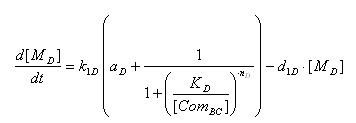Team:NTU-Singapore/Modelling/ODE
From 2008.igem.org
Lalala8585 (Talk | contribs) (→Phosphorylation and Dephosphorylation) |
Lalala8585 (Talk | contribs) (→Regulated Transcription) |
||
| Line 66: | Line 66: | ||
[[Image:Regulated1.JPG|260px|Regulated1]]<br> | [[Image:Regulated1.JPG|260px|Regulated1]]<br> | ||
| - | + | {|border="0"| | |
| - | [P]: Protein Formed | + | |[P]:| Protein Formed|- |
| - | µ: Repression, µ=0;<br> Activation, µ=1 | + | |µ:| Repression, µ=0;<br> Activation, µ=1|- |
| - | K: Hill Constant Value of input that gives 50% response | + | |K:| Hill Constant Value of input that gives 50% response|- |
| - | n: Hill coefficient Slope of signal-response curve at this input signal | + | |n:| Hill coefficient Slope of signal-response curve at this input signal|- |
| - | d: degradation of protein | + | |d:| degradation of protein|- |
| - | k1: basal gene expression | + | |k1:| basal gene expression|- |
| - | k: signal-dependent gene expression | + | |k:| signal-dependent gene expression|- |
| - | a: correlation between k1 and k, 0<a<1 | + | |a:| correlation between k1 and k, 0<a<1|- |
[[Image:Regulated2.JPG|280px|Regulated2]]<br> | [[Image:Regulated2.JPG|280px|Regulated2]]<br> | ||
Revision as of 02:17, 25 October 2008
|
Contents |
ODEs used in modeling
In this section, we will have a short discussion on the ODEs used for Deterministic Modeling in our iGem project.
For the modeling exercise, we use mainly simple linear ODEs to describe the system we have at hand. These ODEs are used to describe processes such as constitutive transcription/ translation etc. Nonlinear equations are used for more complex processes such as regulated transcription. The choice of these equations are in hope that they can describe the system to a relative degree of accuracy and yet be simple enough to be solved. This is very much an engineering compromise between a rigorous description and getting an answer that is good enough which is required.
Our systems are based on the assumptions that Lumped parameter models are sufficient to describe them.
Lumped parameter models are those in which spatial variations are ignored and the dependent variables are uniform throughout the whole system. The only variations are those with respect to time leading to mathematical description in terms of the ODEs used.
The following equations shows the break down of the different equations that will be used in this modeling exercise. By understanding this section, it would make the understanding of the system of ODEs used in our iGEm modeling exercise.
Constant synthesis & Linear Synthesis
- Simple ode to describe constant synthesis
- Gives an explicit analytical solution
- Unique solution once a IC is posed
Linear Degradation
- Rate of degradation is proportional to how much of the molecule is present
- Gives an explicit analytical solution
- Constant half life
Simple Forward Reaction
[C] : Complex
kc : Rate constant of complex formation
This equation ignores the fact that dissociation of the complex occurs. We can do so if the dissociation is much slower than the formation.
- Single solvable equation for the unknown C
- Simple, unique solution available with I.C
Phosphorylation and Dephosphorylation
Assumptions:
- Linear kinetic rate laws apply only if XT is much less than the Michaelis constants of both kinase and phosphotase
| XT : | total cost of X protein in phosphorylated and unphosphorylated form |
| S : | protein kinase concentration |
| k2 : | accounts for protein phosphotase |
- Modeled after simple linear kinetics
- Gives a hyperbolic signal response curve when X plotted vs S
 "
"


